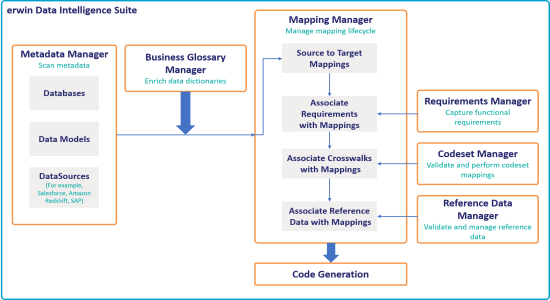To get you started with erwin Data Intelligence Suite (DI Suite), this topic gives you an overview of erwin DI Suite architecture and modules.
The Following diagram shows a high level modular architecture of the application.

The following sequence gives a high level understanding about how the modules interact in a typical data integration project:
- Scan metadata (source/ target) from a data source using Metadata Manager.
- Create business terms and associate it with technical metadata in Business Glossary Manager.
- Perform source to target mappings in Mapping Manager
- Capture functional requirements in Requirements Manager.
- Associate the requirements with mappings in Mapping Manager.
- Define codesets and perform code crosswalks (mappings) in Codeset Manager.
- Associate code crosswalks with mappings in Mapping Manager.
- Validate and manage reference data in Reference Data Manager.
- Associate reference data with Mappings in Mapping Manager.
- Code generation for the following:
- ETL Jobs
- SQL Scripts
- Python Code
- Spark Code
- DDL Scripts
- Stored Procedures
erwin DI Suite consists of 11 modules that are categorized as core and add-on modules. These modules are available via Application Menu.
- The core modules perform the major functions of erwin DI Suite offering.
- The add-on modules offer additional functions on top of the core functions. The availability of add-on modules is subject to licensing.
The following table gives an overview of all the modules and their functions.
|
Module |
Type |
Function |
|---|---|---|
|
Resource Manager |
Core |
It allows you to manage your resources by creating users and roles. You can assign roles to users to give them access-level permissions. |
|
Metadata Manager |
Core |
It allows you to harvest source or target metadata from a data source and makes it available for mappings. You can run impact & lineage analysis to have better control on a data integration project. |
|
Mapping Manager |
Core |
It acts as the core of erwin DI Suite by providing a platform to perform source to target mappings. Further, it allows linking code mapping object, reference data objects and requirements to the mappings. |
|
Codeset Manager |
Add-On |
It enables you to manage your enterprise and legacy codesets. You can perform code mappings (crosswalks) and manage them. |
|
Reference Data Manager |
Add-On |
It enables you to manage all your reference data. You can run validation rules on the reference data and perform data quality checks. Further, you can associate codesets with the reference data. |
|
Business Glossary Manager |
Add-On |
It helps in having better data governance with enriched data dictionaries. It helps in understanding how semantic definitions are related to physical data dictionaries, data mappings, and data lineages. |
|
Requirements Manager |
Add-On |
It enables you to standardize the documentation of functional requirements. Further, you can link requirements with data mappings. |
|
Test Manager |
Add-On |
It enables you to manage test specifications created under Metadata Manager and Mapping Manager. |
|
Release Manager |
Add-On |
It enables you to release data mappings, database objects, and release notes to standardize the release process. |
|
Reports Manager |
Add-On |
It enables you to create and publish reports. It involves report and dashboard configuration. |
|
Workflow Manager |
Add-On |
It enables you to manage workflows in Business Glossary Manager, Metadata Manager, and Mapping Manager. This involves creating custom workflows and monitoring their execution. |
|
Copyright © 2020 erwin, Inc.
All rights reserved.
|
|